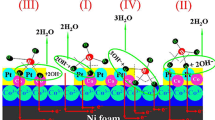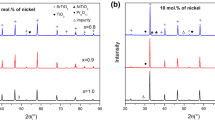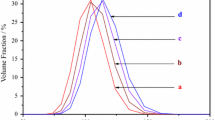Abstract
Electrochemically stable nanostructured nickel titanate (NiTiO3) was prepared by sol-gel method and the structural and electrochemical properties were studied in the presence of H2SO4+CH3OH electrolyte. XRD and Raman studies confirmed the single phase of NiTiO3 with the rhombohedral structure. Thermal stability was studied by TGA. Microstructure analysis by SEM confirmed the uniformly distributed spherical shaped NiTiO3 particles, and TEM studies showed the spherical shaped particles with an average size of 90 nm. The UV-Vis analysis shows the absorption spectrum of NiTiO3, while the FTIR spectrum showed the vibrations related to Ni-O and Ti-O stretching. Electrochemical tests were carried out by cyclic voltammetry (CV) and polarization studies. The CV measurements were made at room temperature as well as at 60°C: at room temperature, the NiTiO3 did not show any activity towards methanol oxidation whereas there observed an activity at the potential of 0.69 V at the operating temperature of 60°C. The ilmenite structured NiTiO3 has oxygen vacancies, most probably on the surface, which could have also contributed to the methanol oxidation. Thus the nanostructured NiTiO3 is proposed to be an active support material for metal electrocatalysts.
Similar content being viewed by others
References
Yamamoto O, Takeda Y, Kanno R, et al. Perovskite-type oxides as oxygen electrodes for high temperature oxide fuel cells. Solid State Ionics, 1987, 22(2–3): 241–246
Taylor D J, Fleig P F, Schwab S T, et al. Sol–gel derived, nanostructured oxide lubricant coatings. Surface and Coatings Technology, 1999, 120–121: 465–469
Wang Y, Santiago-Aviles J J. Synthesis of lead zirconate titanate nanofibres and the Fourier-transform infrared characterization of their metallo–organic decomposition process. Nanotechnology, 2004, 15(1): 32–36
Duan X, Huang Y, Cui Y, et al. Indium phosphide nanowires as building blocks for nanoscale electronic and optoelectronic devices. Nature, 2001, 409(6816): 66–69
Hu J, Odom T W, Lieber C M. Chemistry and physics in one dimension: synthesis and properties of nanowires and nanotubes. Accounts of Chemical Research, 1999, 32(5): 435–445
Lin Y J, Chang Y H, Chen G J, et al. Effects of Ag-doped NiTiO3 on photoreduction of methylene blue under UV and visible light irradiation. Journal of Alloys and Compounds, 2009, 479(1–2): 785–790
Qu Y, Zhou W, Ren Z, et al. Facile preparation of porous NiTiO3 nanorods with enhanced visible-light-driven photocatalytic performance. Journal of Materials Chemistry, 2012, 22(32): 16471–16476
Dong W, Zhu Y, Huang H, et al. A performance study of enhanced visible-light-driven photocatalysis and magnetical protein separation of multifunctional yolk–shell nanostructures. Journal of Materials Chemistry A: Materials for Energy and Sustainability, 2013, 1(34): 10030–10036
Traistaru G A, Covaliu C I, Matei V, et al. Synthesis and characterization of NiTiO3 and NiFe2O4 as catalysts for toluene oxidation. Digest Journal of Nanomaterials and Biostructures, 2011, 6(3): 1257–1263
Cheng F T, Shi P, Man H C. Nature of oxide layer formed on NiTi by anodic oxidation in methanol. Materials Letters, 2005, 59(12): 1516–1520
White J H, Sammells A F. Perovskite anode electrocatalysis for direct methanol fuel cells. Journal of the Electrochemical Society, 1993, 140(8): 2167–2177
Raghuveer V, Viswanathan B. Can La2–xSrxCuO4 be used as anodes for direct methanol fuel cells? Fuel, 2002, 81(17): 2191–2197
Yu H C, Fung K Z, Guo T C, et al. Syntheses of perovskite oxides nanoparticles La1–xSrxMO3–d (M = Co and Cu) as anode electrocatalyst for direct methanol fuel cell. Electrochimica Acta, 2004, 50(2–3): 811–816
Merle G, Wessling M, Nijmeijer K. Anion exchange membranes for alkaline fuel cells: A review. Journal of Membrane Science, 2011, 377(1–2): 1–35
Lin B Y S, Kirk D J, Thorpe S J. Performance of alkaline fuel cells: A possible future energy system? Journal of Power Sources, 2006, 161(1): 474–483
Hernández-Ramírez A, Sánchez-Castro M E, Alonso-Lemus I, et al. Evaluation of the nickel titanate-modified Pt nanostructured catalyst for the ORR in alkaline media. Journal of the Electrochemical Society, 2016, 163(2): F16–F24
Marcilly C, Courty P, Delmon B J. Preparation of highly dispersed mixed oxides and oxide solid solutions by pyrolysis of amorphous organic precursors. Journal of the American Ceramic Society, 1970, 53(1): 56–57
Taguchi H, Matsuda D, Nagao M, et al. Synthesis of perovskitetype (La1–xSrx)MnO3 (0<x<0.3) at low temperature. Journal of the American Ceramic Society, 1992, 75(1): 201–202
Sreedhar K, Mitra A. Low-temperature synthesis of lead tantalate pyrochlore solid solutions Pb1.5 +x(Ta2–yPby)O7–d (0.0<x<0.5; 0.0<y<0.6). Journal of the American Ceramic Society, 2000, 83(2): 418–420
Lopes K P, Cavalcante L S, Simões A Z, et al. NiTiO3 powders obtained by polymeric precursor method: Synthesis and characterization. Journal of Alloys and Compounds, 2009, 468(1–2): 327–332
Pal N, Saha B, Kundu S K, et al. A highly efficient non-enzymatic glucose biosensor based on a nanostructured NiTiO3/NiO material. New Journal of Chemistry, 2015, 39(10): 8035–8043
Baraton MI, Busca G, Prieto MC, et al. On the vibrational spectra and structure of FeCrO3 and of the ilmenite-type compounds CoTiO3 and NiTiO3. Journal of Solid State Chemistry, 1994, 112(1): 9–14
Busco G, Ramis G, Amores J M G, et al. FT Raman and FTIR studies of titanias and metatitanate powders. Journal of the Chemical Society, Faraday Transactions, 1994, 90(20): 3181–3190
Gadsden J A. Infrared Spectra of Minerals and Related Inorganic Compounds. London: Butterworths,1975
Yamaguchi O, Morimi M, Kawabata H, et al. Formation and transformation of ZnTiO3. Journal of the American Ceramic Society, 1987, 70(5): C-97–C-98
Nagai T, Tanimoto T, Yamazaki M. Compression behavior of NiTiO3-ilmenite. Photon Factory Activity Report, 2002, 20(Part B): 221
Ruiz-Preciado M A, Bulou A, Makowska-Janusik M, et al. Nickel titanate (NiTiO3) thin films: RF-sputtering synthesis and investigation of related features for photocatalysis. CrystEngComm, 2016, 18(18): 3229–3236
Mancharan R, Goodenough J B. Methanol oxidation in acid on ordered NiTi. Journal of Materials Chemistry, 1992, 2(8): 875–887
Bellam J B, Ruiz-Preciado M A, Edely M, et al. Visible-light photocatalytic activity of nitrogen-doped NiTiO3 thin films prepared by a co-sputtering process. RSC Advances, 2015, 5(14): 10551–10559
Li T, Wang C C, Lei C M, et al. Conductivity relaxation in NiTiO3 at high temperatures. Current Applied Physics, 2013, 13(8): 1728–1731
Zhou WJ, Zhou B, Li WZ, et al. Performance comparison of lowtemperature direct alcohol fuel cells with different anode catalysts. Journal of Power Sources, 2004, 126(1–2): 16–22
Acknowledgement
Financial support from DST-SERB, India (SR/FTP/ PS-137/2010) to carry out this work is gratefully acknowledged. The CIF of Pondicherry University is also acknowledged.
Author information
Authors and Affiliations
Corresponding author
Rights and permissions
About this article
Cite this article
Chellasamy, V., Thangadurai, P. Structural and electrochemical investigations of nanostructured NiTiO3 in acidic environment. Front. Mater. Sci. 11, 162–170 (2017). https://doi.org/10.1007/s11706-017-0380-1
Received:
Accepted:
Published:
Issue Date:
DOI: https://doi.org/10.1007/s11706-017-0380-1




